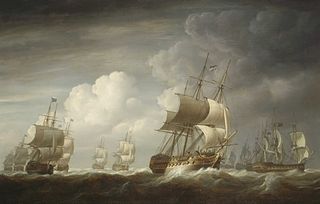Northumberland was launched in 1805. She made six voyages as an extra ship of the British East India Company (EIC), between 1805 and 1818. In 1810 and 1811 she served as a transport in the British invasions of Mauritius and Java. She was sold for breaking up in 1819.
Airly Castle, was built by William Barnard at Deptford and launched in 1787. She made eight voyages as an East Indiaman for the British East India Company (EIC) between 1788 and 1808. In 1795 she participated in the capture of seven Dutch East Indiamen near St Helena. After her eight voyages she may have served briefly as a general transport before she was sold for breaking up in 1810. She was not broken up but instead served as a transport for several years.
Ann was launched at Rotherhithe in the River Thames in 1801. She made eight voyages for the British East India Company (EIC) as an "extra ship", i.e., under charter, between 1801 and 1817. After 1817 she traded with India for some time and she was last listed in 1826.
Lord Keith was launched in 1804 by and for Peter Everitt Mestaer. He chartered her to the East India Company (EIC) for six voyages, and she then went on to make another two voyages for the EIC. On her second voyage, and unusually for an East Indiaman, she participated in the proceeds for the recapture of a former British Royal Navy brig and possibly in a skirmish with a French ship. On her third voyage she participated in a notable action. She was broken up c.1820.
Dover Castle was launched in 1798 as an East Indiaman for the British East India Company (EIC). She made six voyages for the EIC. During the second she transported EIC troops to Macao to augment the Portuguese forces there, but the authorities there refused them permission to land. In 1814 Dover Castle was sold and she served for a half-dozen years as a London-based transport. She was hulked c.1820 and finally broken up in 1826.
Preston was launched in 1798 as an East Indiaman. She made six voyages for the British East India Company (EIC), between 1805 and 1819. In 1810 and 1811 she participated as a transport in two British military campaigns. She was sold for breaking up in 1812 but instead became a transport and a West Indiaman. She disappeared after a gale in August 1815.
William Pitt was launched in 1805 as an East Indiaman. She made seven voyages for the British East India Company (EIC), between 1805 and 1819. In 1810 and 1811 she participated as a transport in two British military campaigns. She was sold for breaking up in 1820.
Union was an East Indiaman that made eight voyages for the British East India Company (EIC) between her launching in 1803 and her sale for breaking up in 1819.
Sir Stephen Lushington was launched in 1796 as an East Indiaman. She made seven voyages for the British East India Company (EIC). During this period she took part as a transport in two military campaigns, the cancelled attack on Manila in 1797, and the capture of Mauritius in 1810. In 1812 she became a West Indiaman, thought around 1816 she made another voyage to India. Thereafter her ownership and trade becomes ambiguous: she either traded with Spain until 1822, or with South America until 1825.

Lord Hawkesbury was launched in 1787 as an East Indiaman for the British East India Company (EIC). She made eight voyages for the EIC before she was sold in 1808 for breaking up.
Europa was launched in 1781 as an East Indiaman. She made six voyages for the British East India Company (EIC). She was probably broken up in 1798.
Deptford was launched in 1781 as an East Indiaman. She made six apparently uneventful voyages for the British East India Company (EIC) before she was sold in 1807 for breaking up.
Devonshire was launched in 1804 as an East Indiaman. She made four voyages for the British East India Company (EIC), and was wrecked on her fifth while still outward bound.
Calcutta was launched in 1798 as an East Indiaman. She made four voyages for the British East India Company (EIC), and disappeared while homeward bound from Bengal on her fifth voyage.

Lady Castlereagh was launched in 1803. She made six apparently uneventful voyages to India and one to China for the British East India Company (EIC). She left the EIC's service and made one voyage transporting convicts to Australia. She was returning from having delivered her convicts to Port Jackson and Van Diemen's Land when she was damaged in October 1818 a gale at Madras. She was surveyed there, condemned, and sold for breaking up.
Worcester was launched in 1785 as an East Indiaman for the British East India Company (EIC). She made eight voyages to India and China for the EIC and participated as a transport in two naval expeditions before she was sold in 1809 for breaking up.
Surrey was launched in 1804 at Deptford as an East Indiaman. She made six voyages for the British East India Company (EIC). She was sold for breaking up in 1816.
Marquis Wellesley was launched at Rotherhithe in 1799. She made five complete voyages for the British East India Company (EIC) before she was lost in 1813 on her sixth.
Lord Duncan was launched on the River Thames in 1798 as an East Indiaman. She made seven voyages for the British East India Company (EIC) before she was sold in 1813 for breaking up.
Asia was launched in 1811 on the River Thames as an East Indiaman. She made 10 voyages for the British East India Company (EIC). She then continued to sail to India and China after the EIC gave up its trading activities in 1834. She was condemned and hulked in 1840.

